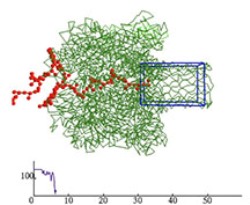Polymer scientist Murugappan Muthukumar at the University of Massachusetts Amherst has received a four-year, $1.08 million grant from NIH’s National Human Genome Research Institute (NHGRI) to find new ways to control the process of reading the precise order of nucleotides in DNA chains as they pass through a nanopore.
The work should lead to cheaper, faster and more accurate gene sequencing for medical research and health care.
 Modeling how a single molecule of DNA (red) squirms through a protein pore (green), embedded in a phospholipid membrane (not shown), under an electric field in a salty aqueous medium.
Modeling how a single molecule of DNA (red) squirms through a protein pore (green), embedded in a phospholipid membrane (not shown), under an electric field in a salty aqueous medium.
In present systems, single molecules of DNA often move through the sequencing platform too fast to be read accurately or they may stutter, taking a molecular step back and forward to be read multiple times.
“We have to somehow guide it, make it behave while it’s passing through,” Muthukumar explains. “Imagine counting and identifying a large group of active young school children as they’re jostling each other through a gate. One kid might be pulling on a friend ahead and actually pull her back through so she is counted twice. It’s much easier to count and identify them if they walk sedately and quietly. That’s our goal with this research on the DNA molecules. We want to find ways to reduce the randomness of the nucleotides’ motion and design molecular brakes to controllably slow the DNA,” he adds.
Designing DNA sequencing platforms requires an understanding at the molecular level of simultaneous effects of the DNA chain’s shape, the barriers it will encounter at the pore entrance, electrostatic forces and electro-hydrodynamic flow effects and such variables as pH, salt concentration and electrical charge. The goal of Muthukumar’s grant is to bring out a fundamental understanding of this complex phenomenon, based on theoretical ideas and computer modeling.
Muthukumar, who is the Wilmer D. Barrett Professor of polymer science and engineering at UMass Amherst, is an expert in the physics of electrophoresis-based DNA sequencing platforms, those that rely on the presence of an electric field to move large molecules through a fluid confined inside protein pores and solid-state nanopores. He is working with nanopores about 1.4 nanometers in diameter. For comparison, a sheet of paper is about 100,000 nanometers thick.
Muthukumar’s latest grant is the third award he has received from NIH’s NHGRI to tackle these problems. “We have made huge progress by bringing fundamental concepts together to explain the various rich experimental data into a single unifying framework,” he notes. “In the end we want to be able to tell manufactures the optimum methods they need to use to reduce noise and improve base-calling, that is, the fidelity of the readout.”